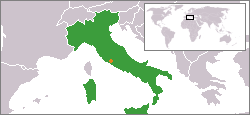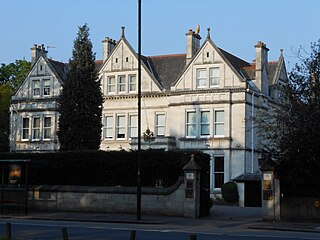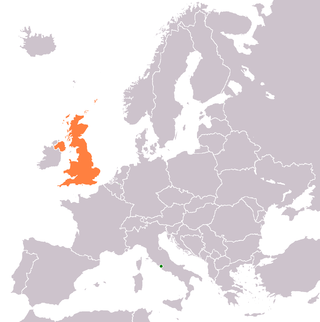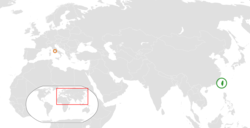
An apostolic nunciature is a top-level diplomatic mission of the Holy See that is equivalent to an embassy. However, it neither issues visas nor has consulates.

The Apostolic Nunciature to the United States, sometimes referred to as the Vatican Embassy, is the diplomatic mission of the Holy See to the United States. It is located at 3339 Massachusetts Avenue, Northwest, Washington, D.C., in the Embassy Row neighborhood. Since 2016, the Papal nuncio has been Archbishop Christophe Pierre.
The Apostolic Nunciature to Ireland the diplomatic mission of the Holy See to Ireland. It is located in Dublin. The position of Apostolic Nuncio is currently vacant.

Holy See–Italy relations refers to the special relationship between the Holy See, which is sovereign over the Vatican City, and the Italian Republic.

The Apostolic Nunciature to Great Britain is a diplomatic office of the Holy See in Great Britain. It is headed by the Apostolic Nuncio who has the rank of an ambassador. The parties agreed to exchange representatives at the ambassadorial level and Pope John Paul II erected the Nunciature to Great Britain on 17 January 1982. Before then, the interests of the Holy See in Great Britain had been represented by an Apostolic Delegate since 1938, though not granted diplomatic status until 1979. The decision to designate the nuncio to Great Britain rather than the United Kingdom reflected the complex and frequently antagonistic relationship between the Holy See and the British crown since they severed ties in the sixteenth century. British government sources said it had been agreed that the nuncio in London would concern himself with matters in England, Scotland and Wales, while the Apostolic Nuncio to Ireland, based in Dublin, would have within his purview the entire island of Ireland.

The Apostolic Nunciature in the Philippines is a top-level diplomatic mission assigned by the Holy See to the Philippines, located at 2140 Taft Avenue, Malate, Manila.

Holy See–United Kingdom relations are foreign relations between the Holy See and the United Kingdom.
The Holy See has long been recognised as a subject of international law and as an active participant in international relations. One observer has stated that its interaction with the world has, in the period since World War II, been at its highest level ever. It is distinct from the city-state of the Vatican City, over which the Holy See has "full ownership, exclusive dominion, and sovereign authority and jurisdiction".

Foreign relations between Argentina and the Holy See, have existed for over a century. The current pope, Pope Francis, was the former Archbishop of Buenos Aires.

Holy See and Indonesia established diplomatic relations in 1950. Relations are important as part of global interfaith dialogue, because Indonesia has the world's largest Muslim-majority population. Indonesia recognizes Roman Catholicism as one of its six approved religions. The Holy See has a nunciature in Jakarta, while Indonesia has an embassy in Rome.

Holy See–Philippines relations refers to the relations between the Holy See and the Philippines. As one of two Catholic-majority countries in Asia, the Philippines enjoys significant relations with the Holy See. The Holy See has a nunciature in Manila, and the Philippines has an embassy to the Holy See based in Rome.
The Apostolic Nunciature to Sri Lanka is the diplomatic mission of the Holy See to Sri Lanka. It is located in Colombo. The Apostolic Nuncio is Archbishop Brian Udaigwe, who was named to the position by Pope Francis on 13 June 2020.

The Apostolic Nunciature to China is the diplomatic mission of the Holy See to the Republic of China. The Republic of China is now more commonly referred to as “Taiwan”. However, as far as the Vatican is concerned, the Republic of China is the state of “China”. The Holy See does not have a diplomatic mission in, or diplomatic relations with, the People's Republic of China (PRC). The Apostolic Nunciature to China is located at 7–1, Lane 265, Heping East Road Section 2, Daan District, Taipei.

The Embassy of the Republic of China (Taiwan) to the Holy See is the diplomatic mission of the Republic of China accredited to the Holy See, one of its few de jure embassies in the world, and the only one remaining in Europe. It also has responsibility for relations with the Sovereign Military Order of Malta.

Central African Republic–Holy See relations refers to the current and historic relationship between the Central African Republic and the Holy See. Diplomatic relations between the two states were established in 1967, but only in recent years they have been increasing their cooperation, with high level visits being made by Pope Francis and President Faustin-Archange Touadéra to each other's countries.

Bulgaria–Holy See relations were formally established in 1990, shortly after the fall of the Bulgarian communist government. Since then, Bulgaria and the Holy See have had an increase in relations, with Pope John Paul II visiting the country in 2002, and more recently visits from Secretary of State Angelo Sodano (2005) and Pietro Parolin (2016).

Holy See–Ivory Coast relations refers to the current relationship between the Holy See and the Republic of Ivory Coast, which was established in 1970. A significant amount of Roman Catholics live in Ivory Coast, being nearly one-fifth of the population, and the two states are considered to have a cordial relationship.

Paul Fitzpatrick Russell is an American prelate of the Catholic Church who was appointed auxiliary bishop of the Archdiocese of Detroit in May 2022. He was previously the Apostolic Nuncio to Turkey, Turkmenistan, and Azerbaijan and the head of the diplomatic mission to Taiwan. In accordance with those roles, he has the personal title of archbishop.





















